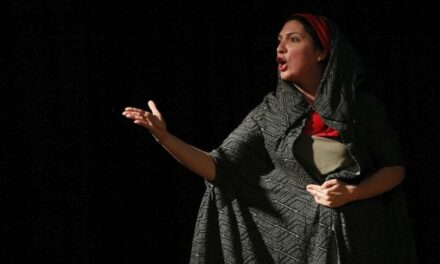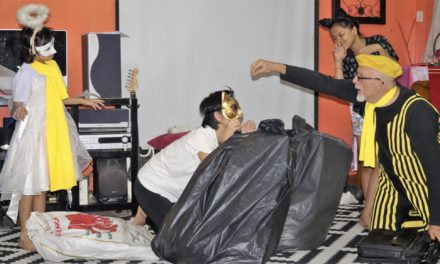Theatre Aotearoa is an archive of stage productions in Aotearoa/New Zealand. The project was initiated by Theatre Studies at Otago University in 2004 and is in active progress. It is intended to be a useful tool for researchers, teachers, students, directors, practitioners and anyone with an interest in the history and development of theatre in this country.
The long-term aim of the database is to record information about every theatre production staged in New Zealand. This includes work by visiting international companies or individuals, such as regular tours by the Allan Wilkie Shakespeare Company throughout the 1920s, Laurence Olivier and Vivien Leigh at the head of the old Vic Company in 1948, the first visit by the Royal Shakespeare Company in 1975, or of Robert LePage who brought The Seven Streams of the River Ota to Wellington’s International Arts Festival in 1998. The database covers a broad sweep of professional and amateur productions. It notes the development of professional theatre companies within New Zealand, such as the 1950s touring New Zealand Players, headed by Richard and Edith Campion, or the rise and fall of more permanent companies such as Wellington’s Downstage, which ran for nearly 50 years, from 1964.
Theatre Aotearoa charts the production history of work by New Zealand writers such as James K. Baxter, Bruce Mason, Roger Hall, Jean Betts, Renée, Briar Grace Smith, Hone Kouka, Gary Henderson, Oscar Kightley, Dave Armstrong and hundreds of others. Closer to home is the Lunchtime theatre series which has played regularly at Otago University’s Allen Hall Theatre since 1974 – a new play is presented every week during the teaching periods of the year.
It also reveals the patterns and popularity of sundry international works. Waiting For Godot was toured by the Community Arts Service Theatre in 1958; Pinter’s The Birthday Party was staged in 1961; Tom Stoppard’s Rosencrantz and Guildenstern Are Dead first appeared in 1969; Kushner’s Angels In America in 1993. Chekhov’s The Bear received an amateur production at Canterbury College, Christchurch in 1936. Rene de Obaldia’s The Wind in the Branches of the Sassafras was a popular choice in the 1970s.
Currently, the earliest production included in the database is The Lawyer Outwitted which played in Auckland, 1841. The earliest Shakespeare presentation currently listed is a dramatic reading of Othello in Dunedin in October 1855 (“Ladies are invited.”) Hamlet (as played by Charles Kemble Mason) was staged in Auckland in April 1856, with The King’s Gardener as an afterpiece, in which the comedian Harry Jackson convulsed the audience by imitating Kemble Mason’s portrayal of the Danish prince.
The database is regularly updated, with additional productions and new material added to extant listings. One current focus is on expanding information about 19th century touring productions, with companies headed by established artists such as George Darrell, Mrs Robert Heir or Herr Daniel E. Bandmann. Clear patterns emerge, such as the popularity of works by Dion Boucicault, or of East Lynne or Bulwer Lytton’s The Lady of Lyons, reflecting international trends of the era.
As well as providing full citations/details for early productions and touring ‘stars’, each individual production is linked directly to any material related to it in the Papers Past website of digitized New Zealand newspapers initiated by the Alexander Turnbull Library in Wellington, at https://paperspast.natlib.govt.nz. Database links provided can be a very useful shortcut for researchers. For example, when Mrs Robert Heir (“effective as ever”) appeared as Rosalind in As You Like It, at the Prince of Wales Theatre, Auckland, on August 26, 1868, a weblink is provided directly to a sample advertisement for the performance in the Daily Southern Cross, while the text of the review from the same newspaper has been transcribed into the production entry. For many other nineteenth-century entries, weblinks are given for the original reviews and other related materials.
Virtually everything on the individual entry pages is designed to be ‘clickable,’ to provide additional information and connection points with other entries. So clicking on the play’s title generates a button at the bottom of the entry entitled ‘Find work is [title]’, and clicking on that button generates a list of all productions of that play. In the case of a work such as Hamlet, this will also generate reference to (for example) Rosencrantz and Guildenstern Are Dead, Sarah Delahunty’s 2b or nt 2b (2008), Jean Betts’ Ophelia Thinks Harder (1996), sundry readings, and a dance/drama piece called The Rest Is Silence (1992). Similarly for author/devisor, which provides a list of all plays by that writer, and for country of origin, director, venue, production company, keywords, genre, actor, designer, event – such as annual festivals – and so on. Clicking on many of these items may also bring up further information – always at the bottom of the entry.
Entries for individual productions vary from brief details of author, play, company and location to more complete representation, including sundry reviews and article listings, full cast and crew, production information, and so on. Incomplete entries will continue to be built up over time. The intention is to provide the fullest possible information for every production staged in New Zealand, from all known source materials.
A longer piece on Theatre Aotearoa may be found here:
Lisa Warrington, “Archiving New Zealand theatre: TADB, the Theatre Aotearoa Database” in Australasian Drama Studies 60 (April 2012), 223 – 228.
This post was written by the author in their personal capacity.The opinions expressed in this article are the author’s own and do not reflect the view of The Theatre Times, their staff or collaborators.
This post was written by Lisa Warrington.
The views expressed here belong to the author and do not necessarily reflect our views and opinions.

















